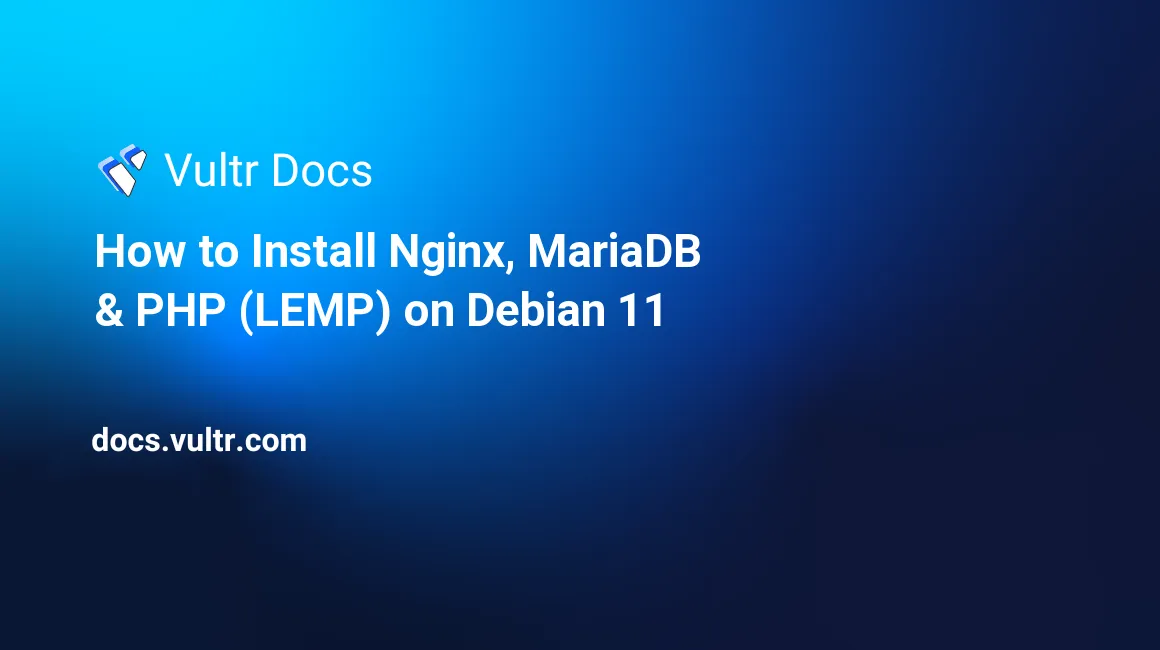
The LEMP stack (Linux, Nginx, MySQL/MariaDB, and PHP) is a free, open-source web application stack used to develop and deploy web applications. The LEMP Stack is like the LAMP stack, but it substitutes Nginx for Apache web server. This guide explains how to install a LEMP stack on Debian 11 and use Certbot to secure it with a Let's Encrypt TLS/SSL certificate.
Prerequisites
- Deploy a Debian 11 cloud server.
- Create a non-root user with sudo access and log in with SSH.
- Update the Debian Server.
This guide assumes you want to use both the apex domain example.com and the www.example.com hostname for your server. To follow this guide, you should assign both the apex domain (sometimes referred to as @) and the www hostname to the server's IP address in your DNS settings.
1. Install Nginx
Install the Nginx web server.
$ sudo apt-get install nginx -yStart the Nginx service.
$ sudo systemctl start nginxEnable the Nginx service to start at system reboot.
$ sudo systemctl enable nginxCheck the Nginx version to verify the installation.
$ sudo nginx -vYou should see output like this:
$ nginx version: nginx/1.18.0
2. Configure the Firewall
List the available application profiles.
$ sudo ufw app listAmong the other entries, you should see the following profiles:
Nginx Full Nginx HTTP Nginx HTTPS* The Nginx Full profile opens both HTTPS (443) and HTTP (80) ports.
- The Nginx HTTP profile opens the HTTP (80) port only.
- The Nginx HTTPS profile opens the HTTPS (443) port only.
Allow the Nginx Full profile in the firewall. Certbot requires ports 80 and 443 to install a Let's Encrypt TLS/SSL certificate.
$ sudo ufw allow 'Nginx Full'Check the Firewall status.
$ sudo ufw statusYou should see output like this:
To Action From -- ------ ---- 22 ALLOW Anywhere Nginx Full ALLOW Anywhere 22 (v6) ALLOW Anywhere (v6) Nginx Full (v6) ALLOW Anywhere (v6)
3. Create an Nginx Virtual Host
Remove the default Nginx configuration.
$ sudo rm -rf /etc/nginx/sites-enabled/default $ sudo rm -rf /etc/nginx/sites-available/defaultCreate an Nginx virtual host configuration file. Replace
your-domain-name.comwith your domain name.$ sudo nano /etc/nginx/sites-available/your-domain-name.comPaste this into the file. Replace
example.comwith your domain name.server { listen 80; server_name example.com www.example.com; root /var/www/html; index index.php index.html index.nginx-debian.html; access_log /var/log/nginx/example_access.log; error_log /var/log/nginx/example_error.log; location / { try_files $uri $uri/ /index.php$is_args$args; } location ~ \.php$ { try_files $uri =404; fastcgi_index index.php; include fastcgi_params; fastcgi_pass unix:/run/php/php7.4-fpm.sock; fastcgi_param SCRIPT_FILENAME $document_root$fastcgi_script_name; } }Enable the new Nginx configuration. Replace
example.comwith your domain name.$ sudo ln -s /etc/nginx/sites-available/example.com /etc/nginx/sites-enabled/example.comReload the Nginx service.
$ sudo systemctl reload nginx
4. Install MariaDB
Install MariaDB database server.
$ sudo apt-get install mariadb-server -yStart the MariaDB service.
$ sudo systemctl start mariadbEnable the MariaDB service to start at system reboot.
$ sudo systemctl enable mariadb
5. Secure MariaDB Database Server
MariaDB provides a security script to secure the database. Run it and answer all the security questions as shown.
$ sudo mysql_secure_installationInitially, there is no password for root. Press Enter.
Enter current password for root (enter for none): OK, successfully used password, moving on...Press Y to Switch to unix_socket authentication.
Switch to unix_socket authentication [Y/n] Y Enabled successfully! Reloading privilege tables.. ... Success!Press Y to change the root password.
Change the root password? [Y/n] Y New password: Re-enter new password: Password updated successfully! Reloading privilege tables.. ... Success!Press Y to remove anonymous users.
Remove anonymous users? [Y/n] Y ... Success!Press Y to remove remote root login.
Disallow root login remotely? [Y/n] Y ... Success!Press Y to remove test database and access to it.
Remove test database and access to it? [Y/n] Y - Dropping test database... ... Success! - Removing privileges on test database... ... Success!Press Y to reload the privilege tables.
Reload privilege tables now? [Y/n] Y ... Success! Cleaning up... All done! If you've completed all of the above steps, your MariaDB installation should now be secure. Thanks for using MariaDB!Connect to the MariaDB shell and enter your MariaDB root password.
$ sudo mysql -u root -pCheck the MariaDB version to verify the installation.
MariaDB [(none)]> SELECT @@version;It should return something like this:
+---------------------------+ | @@version | +---------------------------+ | 10.5.12-MariaDB-0+deb11u1 | +---------------------------+ 1 row in set (0.000 sec)Exit MariaDB shell.
MariaDB [(none)]> exit
6. Install PHP
Install PHP-FPM 7.4 and other required packages.
$ sudo apt-get install php php-fpm php-curl php-cli php-zip php-mysql php-xml -yCheck the PHP version to verify the installation.
$ php -vIt should return something like this:
PHP 7.4.28 (cli) (built: Feb 17 2022 16:17:19) ( NTS ) Copyright (c) The PHP Group Zend Engine v3.4.0, Copyright (c) Zend Technologies with Zend OPcache v7.4.28, Copyright (c), by Zend TechnologiesCreate a PHP test file in your editor.
$ sudo nano /var/www/html/phpinfo.phpPaste this into your
phpinfo.phpfile.<?php phpinfo(); ?>Save and exit the file.
In your browser, navigate to
http://www.example.com/phpinfo.phpto view the PHP test file, which shows the PHP information.
7. Install a Let's Encrypt Certificate
Certbot requires Snap. Install
snapdand enable classic Snap support.$ sudo apt install snapdEither log out and back in again, or restart your system, to update Snap’s paths.
Install the core Snap to get the latest
snapd.$ sudo snap install coreUpdate core Snap.
$ sudo snap refresh coreVerify there are no Certbot packages installed with
apt.$ sudo apt remove certbotInstall Certbot with Snap.
$ sudo snap install --classic certbotLink Certbot to
/usr/bin.$ sudo ln -s /snap/bin/certbot /usr/bin/certbotRequest a certificate for your server. Replace the example email and domains your values. The command shown requests a multi-domain (SAN) certificate for
example.comandwww.example.com.$ sudo certbot --nginx --agree-tos --redirect --email your_email@example.com -d example.com -d www.example.comTest your SSL configuration on an SSL check website like SSL Labs.
Navigate to your website and verify the SSL certificate works as expected.
This completes the initial setup of your LEMP server. The server is ready for you to install applications that work with LEMP, or develop your own.